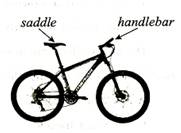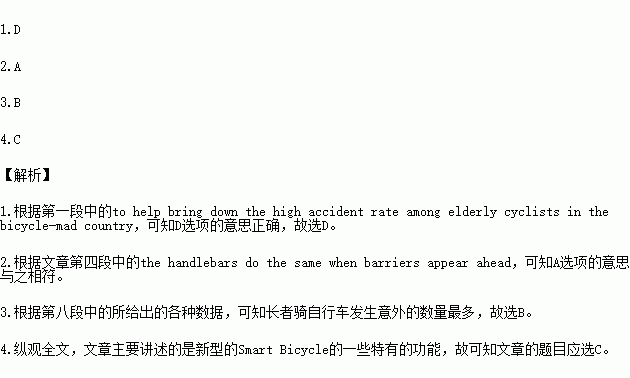题目内容
The Netherlands on Monday introduced its first-ever intelligent bicycle, fitted with electronic devices to help bring down the high accident rate among elderly cyclists in the bicycle-mad country.

Developed for the government by the Netherlands Organization for Applied Scientific Research (TNO), the intelligent bicycle, runs on electricity.A commercial-available bicycle is expected to be on the market in the next two years and should sell for between 1, 700 to 3, 200 euros per bicycle.
The devices on the bike are linked through an onboard computer with a vibrating (震动的) warning system fitted in the bicycle's saddle and handlebars to warn cyclists of the coming danger.
The saddle vibrates when other cyclists approach from behind, while, the handlebars do the same when barriers appear ahead.
“Accidents often happen when cyclists look behind them or get a fright when they are passed at high speed, ”said Maurice Kwakkernaat, one of TNO's research scientists involved in the project.“The onboard system technology has already been at work in the car industry, ”he said.
“More and more elderly people are using a bicycle, not only for short distances, but also for longer distances, ”Dutch Environment and Infrastructure Minister Melanie Schultz van Haegen told AFP.“This type of bicycle is truly needed in the Netherlands because it will help us bring down the number of elderly people who are injured every year and allow them to continue to enjoy cycling, ”she said.
In the Netherlands, bicycles outnumber the population of 17 million by at least one million and there are some 25,000 km of bicycle path in the country.Those statistics are set to grow as more and more people take to two-wheeled transport, leading to an increased risk of injury.
Last year, 184 cyclists died in the country, of which 124, or 67%, were older than 65, according to the Central Statistics Office.The year before, 200 cyclists died, the majority of victims also being elderly.
The current model weighs 25 kilograms but researchers are working on making the onboard systems smaller.
1.The intelligent bicycle is aimed to ________.
A.protect the environment
B.help reduce traffic pressure
C.popularize the use of bicycles
D.improve safety for elderly cyclists
2.Which part of the intelligent bicycle will vibrate when another cyclist was suddenly found ahead ?
A.The handlebars.
B.The wheels.
C.The saddle.
D.The onboard computer.
3.We can learn from the passage that ________.
A.the elderly ride bicycles wherever they go
B.the accident rate among elderly cyclists is high
C.the number of elderly cyclists is decreasing
D.the elderly are planning to give up cycling
4.Which is the best title for the passage?
A.A Test Bicycle
B.Elderly Cyclists
C.A Smart Bicycle
D.A Bicycle-mad Country
根据所提供语境,用方框中所给短语的适当形式填空。(每题1.5分,共15分)
call … up make one’s acquaintance with set about by means of in vain hesitate for a moment in terms of get through occur to have a great impact on |
1. It was in New York that I first _________ Professor Smith.
2.Though she _________, she finally went in and asked to try on a dress that was expensive.
3.________weather, here is a good place for the tour.
4.The picture _____ him ______ the time when he was brought up in the village.
5.One afternoon she ____ riding without an umbrella and was caught in a storm at last.
6.She told her husband that she couldn’t _____ the rest of the housework without his help.
7.After the quarrel, I tried my best to fix the misunderstanding between us, but all my efforts seemed_________.
8.What the teachers have done _______ their students in the future.
9.Our teachers are trying to improve our English _______ listening, reading, writing and speaking.
10.It _____ me that I had left my suitcase in the taxi, in which I came home yesterday.

